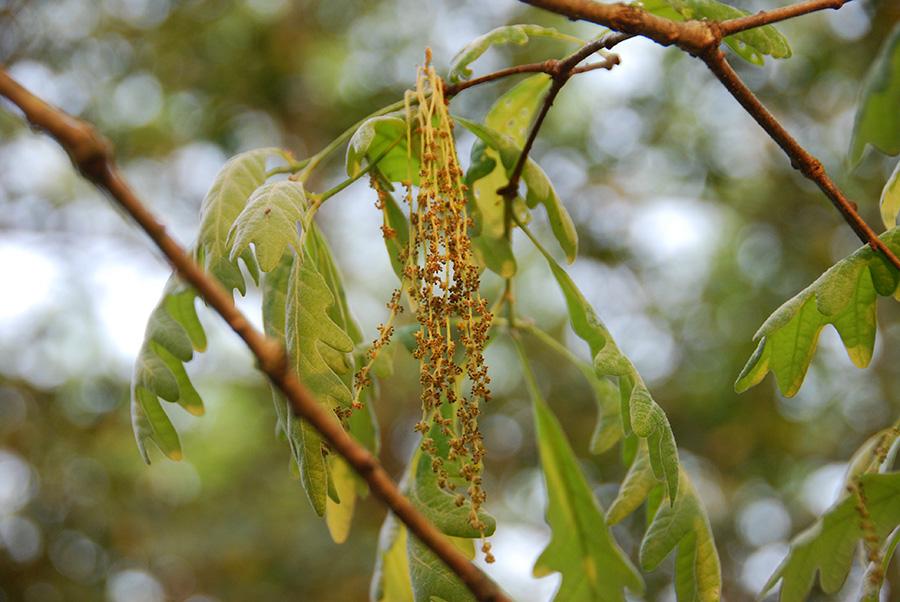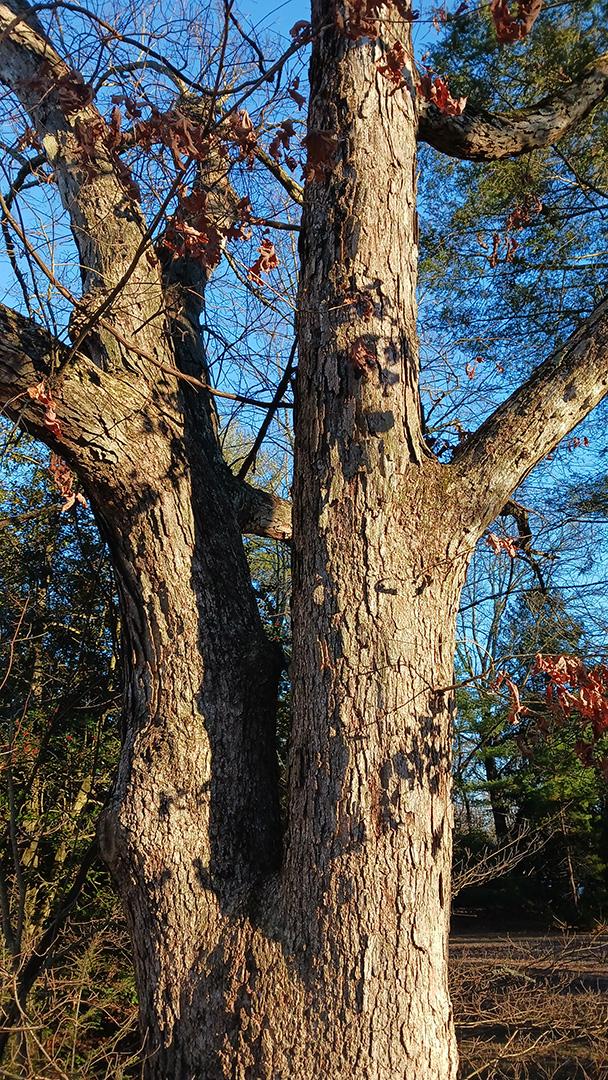John Hooven, UME Forest Stewardship Educator

White oak catkins and leaves.
The white oak is, without a doubt, a remarkable tree species. The tree is truly an impressive specimen where older examples are found growing in the open landscape. It is no wonder that this species of oak is Maryland’s state tree. The largest white oak specimen found to date was the Wye Oak at Wye Mills in Talbot County that had a circumference of nearly 32 feet. It perished in a storm in 2002 and was thought to be over 500 years old. Valued for its resources, its place in the landscape as well as its benefits for wildlife, it is hard to find any tree species upon which so many other species depend heavily.

White oaks are a native tree species in the genus Quercus. Here in North America, Quercus are divided into two groups: red oaks and white oaks. Quercus alba is the leading representative of the white oak group. White oak has a light gray bark and gray branches. The leaves of white oak are lobed with rounded edges and have shallow to deep sinuses, 5-9 lobes per leaf. Trees typically have shallow furrows that grow scaly with age. Indeed, when observing a mature species in the forest, the shallow furrows that we see near the ground transition further up the tree into larger scaly, flaking plates. It is one of the leading ways to identify white oak in the forest especially in the winter when the leaves are absent from the trees.
White oaks are found in the landscape throughout the entire state of Maryland. They grow in drier soils but can be found in uplands as well as drier lowlands. They are least likely to be found along drier ridge tops and in wetter bottomlands.
White oak is a slow growing tree. The species is a long-lived tree easily outlasting species in the red oak group of trees. White oaks can typically live 200-600 years, making them one of the oldest growing deciduous species in Maryland by age. Its slow growth produces a strong, tightly grained wood. This characteristic makes white oaks excellent for making barrels for ageing wine and whiskey. The species is monoecious; the female parts that develop into acorns, and the male flowering catkins, grow on the same tree. White oaks generally reach sexual maturity to start producing acorns at about fifty years of age, though
some open field grown species will start producing acorns at twenty years. Acorns take a year to produce. However, as with other oaks, individual trees experience “mast years,” where development of acorns will be much heavier than other years. Additionally, some years, development will be non-existent.
Many wildlife species are dependent on the white oak, including many butterflies, moths, squirrels, turkeys, as well as other insects and birds. The versatility of its wood has been used on everything from railroad ties, trim, and lumber, to furniture, cabinetry, and flooring. Its wood is also used as beams and planks in sailing ships. In fact, the USS Constitution, “Old Ironsides,” is made with white oak. The replacement planking on Maryland’s tall ship, Pride of Baltimore II, is also white oak. The species is considered the most important of the oaks for timber.

Changes in land management are leading to a decline in propagation of white oaks in forests. The “White Oak Initiative” was established to reverse this trend. White oak has a very long rotation cycle when grown as timber in the forest when compared to other species. Additionally, natural regeneration is most probable only during mast years. Therefore, without prudent management and intervention, there will be a decline in white oaks in the landscape over the next century. As such an essential species in the environment, this could have a negative impact on the many species that depend on this important tree. Let us give a salute, then, to the white oak, Maryland’s state tree.
Branching Out, Vol. 32, no. 1 (Winter 2024)
Branching Out is the free, quarterly newsletter of the Woodland Stewardship Education program. For more than 30 years, Branching Out has kept Maryland woodland owners and managers informed about ways to develop and enhance their natural areas, how to identify and control invasive plants and insects, and about news and regional online and in-person events.